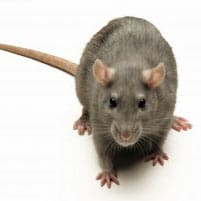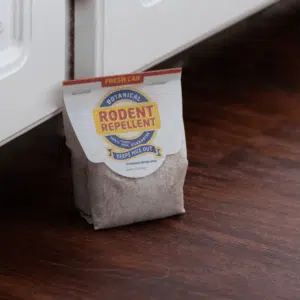Best Ways to Get Rid of Rats Around the House
By : Rita Stadler
Have a rat problem? When thinking about getting rid of rats, many people jump to the conclusion to kill them or trap these unwanted pests. However, there are alternative solutions that can be better for both long-term prevention and helping to preserve nature’s delicate ecosystem.
Some common approaches people take to remove this problem from their home include:
- Closing all openings and taking away shelter
- Using no-kill repellents
- Using mouse traps to catch rats
- Using poison to kill rats
Below we’ll discuss each of these options along with the pros and cons of each to help you determine the best way to remove them from your home.
A Little Background Information
The average person tends to immediately lean towards extermination when it comes to choosing pest control options. When it comes to rat removal, taking the time to manage the problem and prevent it from happening again is more effective in the long term.
Because of their reproductive nature, rat populations are notoriously difficult to wipe out. A female rat can mate around 500 times in a six-hour period and brown rats can produce up to 2,000 offspring in a year, according to Discover Magazine. With this amount of possible offspring adding to your problem, methods such as glue traps, poison baits, and snap traps will only do so much.
Whether you’re a homeowner, business owner, or renter, you want to make your place unattractive to these critters and make a plan for keeping the problem at bay moving forward.
How to Get Rid of Rats
The first step to removing these pesky critters from your home is to locate the problem and find the areas that have been impacted by the infestation. Clean the areas thoroughly (using the appropriate steps if rodent droppings are involved), and remove any food sources from the area. Then you must find and close the entry points you believe they are coming in through, and consider a repellent to prevent them from returning in the future.
Close All Entry Points
To prevent rats from entering or re-entering your spaces, caulk any openings including vent holes and the smallest cracks and holes. Sheet metal around pipe entrances and along door bottoms prevents them from chewing through. You can fill gaps around pipes with cement to keep them out.
Take away any objects that they can use as a home. Remove woodpiles from your property, get rid of old furniture and car bodies, throw away all trash and debris in and around your home, and take down outside buildings that you don’t use. Cut down or thin out any dense plant growth too.
While this is a great practice no matter which method you choose, if you only go this route it may take a while for them to leave after you successfully seal all openings and rid your property of potential homes. It is also easy to miss entrances and shelters so it could be frustrating as you try to find them all. Try looking for common signs like feces or gnaw marks.
Where Do They Live?
These pests live in areas that provide them with enough food and water to survive along with a protective shelter or nesting materials. Norway rats live in the ground and make their nests under buildings, in basements, on creek banks, and in sewers or piles of garbage. They eat almost anything they can find, including meat scraps, garbage, and sewage.
Roof rats live above the ground inside buildings, in sheds, trees, and shrubs, and in piles of wood. These climbers are fond of any kind of pet food and food scraps.
Repellent Methods
There are multiple repellent methods, many of which offer a way to get rid of rats without killing them. Botanical repellents, ultrasonic repellents, peppermint oil, and mothballs are a few of the common approaches used for rat control.
Use a Botanical Rodent Repellent
Fresh Cab® is a safe and easy way to get rid of rodents. There are no health risks associated with Fresh Cab when used as directed. You don’t need to worry about using it around children and pets. Simply place the pouches in areas where they live, and the scent created by botanical essential oils works to drive them away.
You won’t need to search your house for poisoned bodies or worry about disease as you toss them out with traps.
The Environmental Protection Agency (EPA) tested Fresh Cab® and found it to be safe and effective when used as directed. Fresh Cab® is the only plant-based rodent repellent on the market that can make this claim, and the results are guaranteed.
Alternative Ways That Aren’t Recommended
Along with the strategies mentioned above, many people turn to traps or killing methods when it comes to removing rats. While we do not recommend these methods, we’ve included information on them below.
Traps
A well-fed rat will not be interested in eating the bait used in traps or poison. You need to eliminate their food source before setting up anything. This means keeping garbage cans tightly closed and keeping all food in sealed containers.
Fixing leaky faucets and making sure drain covers are securely covered will make it difficult for them to get water. Peanut butter and bacon grease are popular choices to use for baiting, but you can use any food that they will eat.
Rat traps leave you with the problem of getting rid of the dead rat. This task is not for the squeamish and presents a health risk to everyone. Handling them exposes you to the variety of diseases and parasites they carry. Also, as fast as they can multiply, this method only deals with one rodent at a time.
Poison
Similarly to using traps, it will be necessary to first rid the area of any possible food sources in order to create a willingness to eat an uncommon form of food. Be sure to seal all food, including pet food, in air-tight containers, clear table scraps and crumbs immediately, and ensure that your trashcan is secure.
Once the rat does take the poison, it will not work immediately, and they can travel back to their hiding spots before dying.
These hiding spots are sometimes the insides of walls. Once they start to decompose it creates a horrible smell and attracts flies and other insects.
Hire an Exterminator
Another option is to turn to the professionals and hire an exterminator to come to your home and deal with the issue. Exterminators often use harsh chemicals and the service they provide will oftentimes need to be repeated routinely to keep the problem from coming back.
Summary
While there are many options to choose from when it comes to getting rid of rats in your house, most are either a short-term solution or are not proven to work effectively.
Our botanical rodent repellents are lab-proven to be effective. Not only do they help to clear a current infestation, but the pouches also work to prevent a pest problem from resurfacing in your home. Fresh Cab® and Stay Away® Rodent provide solutions that are fast-acting, and help to preserve our ecosystem.









